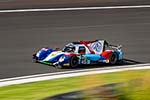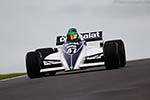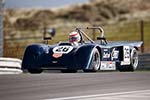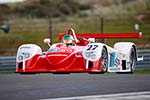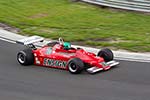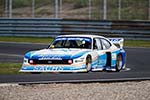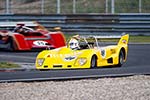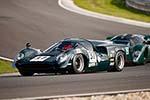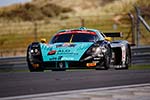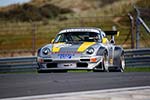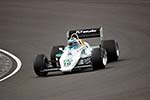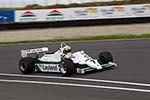A delayed debut

With the track assigned to host the first Dutch Grand Prix since 1985, Circuit Zandvoort has been in the spotlight during the last year. In order to stage the first Formula 1 World Championship round in The Netherlands in 35 years, some modifications had to be made. Purists feared the old school track would be ruined but an interesting compromise was reached. The problem areas were addressed not by adding acres of run-off but by dramatically changing the grade of the corner. This created two banked corners that are unique to the World Championship. Sadly, Formula 1 did not get to sample the track yet this year due to COVID-19 pandemic. After a quiet spring and summer, the sounds of racing cars finally reverberated through the dunes of Zandvoort again at the start of September. The occasion was the annual Historic Grand Prix; the first international event hosted on the track since the outbreak of the pandemic.
We were at CM.com Circuit Zandvoort to explore the changes and to find some new angles, all of which can be found in our action-packed
100-shot gallery.
Grassroots racing

While the Historic Grand Prix was allowed to take place, there were still many travel restrictions to take into consideration. This particularly affected the British entrants and teams. As a result, the programme was quite a bit different than in years past. The situation allowed several Dutch and German championships to feature prominently. For us, it was refreshing to get a closer look at the grassroots of historic motor racing. Series open to Mazda MX-5s, Porsche 944s and 3-Series BMWs, are a lot more accessible to a lot more people than most events we cover. Of course even these fields featured more exotic machinery like a Group A Ford Sierra Cosworth. A particular interesting series was the German Kampf der Zwerge or battle of the dwarves. As the name suggests, this was open to small cars, so naturally there were a lot of Minis and Fiat Abarths but we also had the privilege to see a bona fide Lada race for the first time. Making sure everybody took notice, the owner had also painted the car in a striking Gulf Oil-inspired livery.
Sports car spectacle

Spread over several grids, sports cars really took centre stage during this year's Historic Grand Prix. Big, thundering Can-Am cars lined up in the German 100 Meilen Trophy, while the Masters Sports Car Trophy saw a field of Lolas and Chevrons go head-to-head, joined by a rare Osella-Abarth. One of the absolute headliners was the Aston Martin Masters Endurance Legends. A relatively new addition to the Masters program, this series is open to sports prototypes and GT racers of the past 25 years. Among the most interesting cars on hand at Zandvoort this weekend were a Maserati MC12, a Dallara SP1 Judd and a howling Aston Martin V12 Vantage GT3. Fastest of all was the BR 01 Nissan of Jack Dex. Built to compete in the LMP2 class during the 2015 and 2016 seasons, this particular machine was never actually raced in period. The British BBM Sport team recently bought five of the eight cars built and fielded this example for Dex. He won the opening 40-minute race in the Nissan engined prototype and would have won the second had he not been penalised for an un-safe release. The win, instead, went to the MC12 driven by local heroes David Hart and Nicky Pastorelli.
Formula 1

With contemporary Formula 1 cars not due to race at the upgraded Circuit Zandvoort until May of 2021, the competitors in the Masters Formula One championship were the first to sample the track in an F1 racer. Despite the travel restrictions and challenging economic situation, it was good to see 15 cars take to the track. An F1 car that had grabbed a lot of attention before the weekend was the freshly built Tyrrell P34. This had been constructed for an American enthusiasts by specialists CGA Engineering with permission of the Tyrrell family. Sadly, the six-wheeler could not take to the track this weekend as the driver was stuck on the other side of the Atlantic. That certainly did not take away from the action on the track, which saw Mike Cantillon pilot his Williams FW07C around the new Grand Prix circuit at mind boggling speeds. He snatched pole position for the two 25-minute races and managed to convert both into convincing victories. On both occasions, German ace Marco Werner was second and first in class with his slightly earlier Lotus 77.
Final thoughts
When it was announced that in order to host a Grand Prix, Circuit Zandvoort had to be modified, many feared that the unique character of the track would be lost. It was a relief to see that despite the considerable changes to the track, it was still very much Zandvoort. Without exception, the drivers we spoke to were positive and even for us photographers there were some new opportunities. To see just which, we would like to refer to our exclusive
100-shot gallery.

 With the track assigned to host the first Dutch Grand Prix since 1985, Circuit Zandvoort has been in the spotlight during the last year. In order to stage the first Formula 1 World Championship round in The Netherlands in 35 years, some modifications had to be made. Purists feared the old school track would be ruined but an interesting compromise was reached. The problem areas were addressed not by adding acres of run-off but by dramatically changing the grade of the corner. This created two banked corners that are unique to the World Championship. Sadly, Formula 1 did not get to sample the track yet this year due to COVID-19 pandemic. After a quiet spring and summer, the sounds of racing cars finally reverberated through the dunes of Zandvoort again at the start of September. The occasion was the annual Historic Grand Prix; the first international event hosted on the track since the outbreak of the pandemic.
With the track assigned to host the first Dutch Grand Prix since 1985, Circuit Zandvoort has been in the spotlight during the last year. In order to stage the first Formula 1 World Championship round in The Netherlands in 35 years, some modifications had to be made. Purists feared the old school track would be ruined but an interesting compromise was reached. The problem areas were addressed not by adding acres of run-off but by dramatically changing the grade of the corner. This created two banked corners that are unique to the World Championship. Sadly, Formula 1 did not get to sample the track yet this year due to COVID-19 pandemic. After a quiet spring and summer, the sounds of racing cars finally reverberated through the dunes of Zandvoort again at the start of September. The occasion was the annual Historic Grand Prix; the first international event hosted on the track since the outbreak of the pandemic. While the Historic Grand Prix was allowed to take place, there were still many travel restrictions to take into consideration. This particularly affected the British entrants and teams. As a result, the programme was quite a bit different than in years past. The situation allowed several Dutch and German championships to feature prominently. For us, it was refreshing to get a closer look at the grassroots of historic motor racing. Series open to Mazda MX-5s, Porsche 944s and 3-Series BMWs, are a lot more accessible to a lot more people than most events we cover. Of course even these fields featured more exotic machinery like a Group A Ford Sierra Cosworth. A particular interesting series was the German Kampf der Zwerge or battle of the dwarves. As the name suggests, this was open to small cars, so naturally there were a lot of Minis and Fiat Abarths but we also had the privilege to see a bona fide Lada race for the first time. Making sure everybody took notice, the owner had also painted the car in a striking Gulf Oil-inspired livery.
While the Historic Grand Prix was allowed to take place, there were still many travel restrictions to take into consideration. This particularly affected the British entrants and teams. As a result, the programme was quite a bit different than in years past. The situation allowed several Dutch and German championships to feature prominently. For us, it was refreshing to get a closer look at the grassroots of historic motor racing. Series open to Mazda MX-5s, Porsche 944s and 3-Series BMWs, are a lot more accessible to a lot more people than most events we cover. Of course even these fields featured more exotic machinery like a Group A Ford Sierra Cosworth. A particular interesting series was the German Kampf der Zwerge or battle of the dwarves. As the name suggests, this was open to small cars, so naturally there were a lot of Minis and Fiat Abarths but we also had the privilege to see a bona fide Lada race for the first time. Making sure everybody took notice, the owner had also painted the car in a striking Gulf Oil-inspired livery. Spread over several grids, sports cars really took centre stage during this year's Historic Grand Prix. Big, thundering Can-Am cars lined up in the German 100 Meilen Trophy, while the Masters Sports Car Trophy saw a field of Lolas and Chevrons go head-to-head, joined by a rare Osella-Abarth. One of the absolute headliners was the Aston Martin Masters Endurance Legends. A relatively new addition to the Masters program, this series is open to sports prototypes and GT racers of the past 25 years. Among the most interesting cars on hand at Zandvoort this weekend were a Maserati MC12, a Dallara SP1 Judd and a howling Aston Martin V12 Vantage GT3. Fastest of all was the BR 01 Nissan of Jack Dex. Built to compete in the LMP2 class during the 2015 and 2016 seasons, this particular machine was never actually raced in period. The British BBM Sport team recently bought five of the eight cars built and fielded this example for Dex. He won the opening 40-minute race in the Nissan engined prototype and would have won the second had he not been penalised for an un-safe release. The win, instead, went to the MC12 driven by local heroes David Hart and Nicky Pastorelli.
Spread over several grids, sports cars really took centre stage during this year's Historic Grand Prix. Big, thundering Can-Am cars lined up in the German 100 Meilen Trophy, while the Masters Sports Car Trophy saw a field of Lolas and Chevrons go head-to-head, joined by a rare Osella-Abarth. One of the absolute headliners was the Aston Martin Masters Endurance Legends. A relatively new addition to the Masters program, this series is open to sports prototypes and GT racers of the past 25 years. Among the most interesting cars on hand at Zandvoort this weekend were a Maserati MC12, a Dallara SP1 Judd and a howling Aston Martin V12 Vantage GT3. Fastest of all was the BR 01 Nissan of Jack Dex. Built to compete in the LMP2 class during the 2015 and 2016 seasons, this particular machine was never actually raced in period. The British BBM Sport team recently bought five of the eight cars built and fielded this example for Dex. He won the opening 40-minute race in the Nissan engined prototype and would have won the second had he not been penalised for an un-safe release. The win, instead, went to the MC12 driven by local heroes David Hart and Nicky Pastorelli. With contemporary Formula 1 cars not due to race at the upgraded Circuit Zandvoort until May of 2021, the competitors in the Masters Formula One championship were the first to sample the track in an F1 racer. Despite the travel restrictions and challenging economic situation, it was good to see 15 cars take to the track. An F1 car that had grabbed a lot of attention before the weekend was the freshly built Tyrrell P34. This had been constructed for an American enthusiasts by specialists CGA Engineering with permission of the Tyrrell family. Sadly, the six-wheeler could not take to the track this weekend as the driver was stuck on the other side of the Atlantic. That certainly did not take away from the action on the track, which saw Mike Cantillon pilot his Williams FW07C around the new Grand Prix circuit at mind boggling speeds. He snatched pole position for the two 25-minute races and managed to convert both into convincing victories. On both occasions, German ace Marco Werner was second and first in class with his slightly earlier Lotus 77.
With contemporary Formula 1 cars not due to race at the upgraded Circuit Zandvoort until May of 2021, the competitors in the Masters Formula One championship were the first to sample the track in an F1 racer. Despite the travel restrictions and challenging economic situation, it was good to see 15 cars take to the track. An F1 car that had grabbed a lot of attention before the weekend was the freshly built Tyrrell P34. This had been constructed for an American enthusiasts by specialists CGA Engineering with permission of the Tyrrell family. Sadly, the six-wheeler could not take to the track this weekend as the driver was stuck on the other side of the Atlantic. That certainly did not take away from the action on the track, which saw Mike Cantillon pilot his Williams FW07C around the new Grand Prix circuit at mind boggling speeds. He snatched pole position for the two 25-minute races and managed to convert both into convincing victories. On both occasions, German ace Marco Werner was second and first in class with his slightly earlier Lotus 77. 

